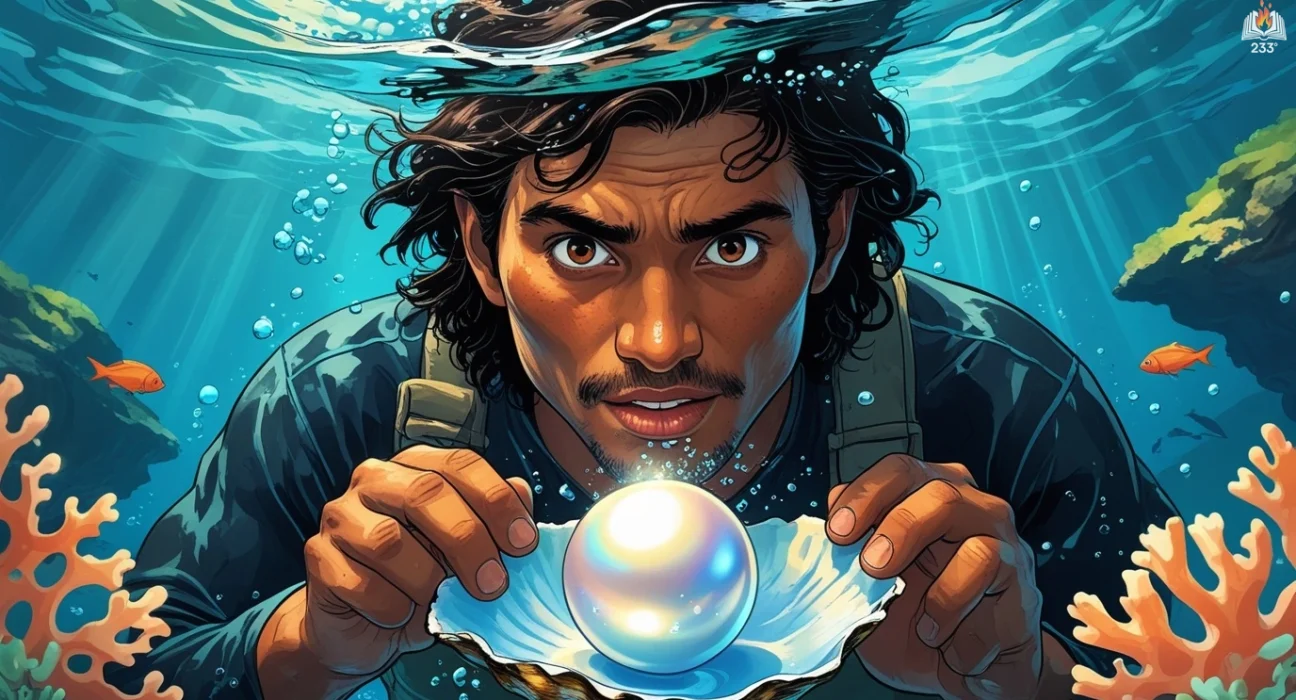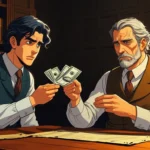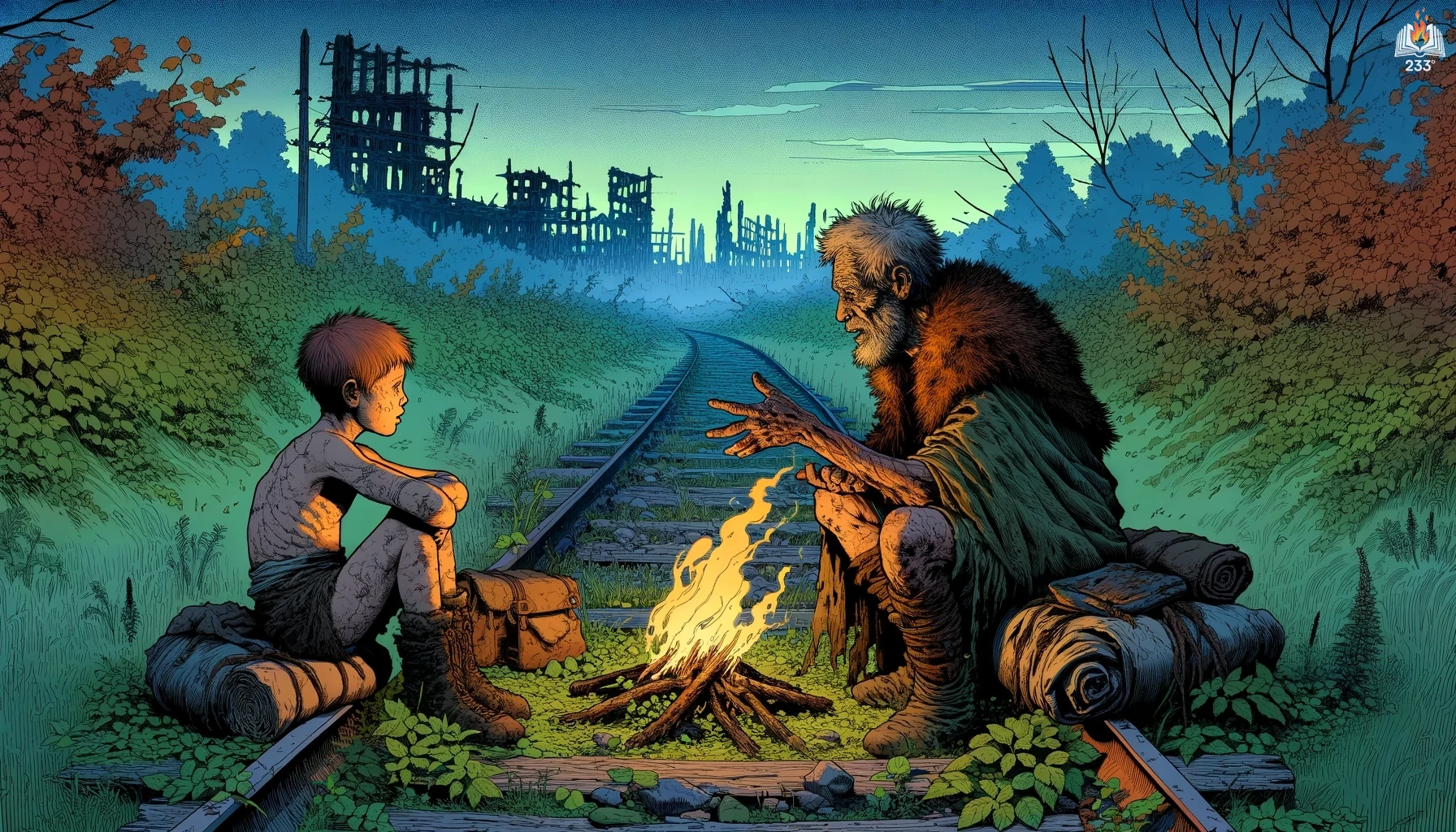The Pearl (1947) by John Steinbeck is a parable-like novella about Kino, a poor fisherman who discovers a magnificent pearl. Set in a small Mexican coastal village, the story explores themes of greed, family, and human nature as Kino’s discovery brings hope and tragedy to his family.
Plot Summary
Kino woke to the faint stirrings of dawn, the sky still painted with the deep hues of night. Beside him, Juana, his wife, already tended to their infant son, Coyotito. In their modest brush house, life was simple, defined by rituals that stretched back generations. The sounds of the sea and the hum of the village began to rise with the light, and Kino felt the familiar rhythm of the Song of the Family in his heart, a melody of safety and love that had always anchored him.
But peace is fragile, and the day soon brought its first shadow. Coyotito, lying in his hanging cradle, was stung by a scorpion. Juana, swift and steady, sucked the poison from the wound, but worry gnawed at her. The villagers gathered, murmuring about the danger the sting posed to such a small child. When Juana insisted that the doctor be summoned, the crowd hesitated; they all knew the doctor cared little for the poor and would never cross the line dividing the brush houses from the stone dwellings of the town. Yet Juana’s determination drove Kino to take her and their child to the doctor’s house.
The journey through the village carried an air of quiet defiance. The doctor, wrapped in his own comforts and disdain for the impoverished, refused to see them. Kino’s offering of small, misshapen pearls was deemed worthless. The gate to the doctor’s home slammed shut, and Kino’s helpless anger burst forth in a single blow against the gate. The sting of humiliation lingered as they returned to their home, but Juana’s faith did not falter. She prayed not only for Coyotito’s recovery but for a sign—a way to save her child.
The next morning, Kino and Juana took to the sea in Kino’s canoe, an heirloom passed down through generations and their sole means of livelihood. Kino dove deep into the shimmering waters, gathering oysters in his search for pearls. Among the rough shells lay one of unnatural size, its surface gleaming faintly even through the murk of the sea. Kino’s heart quickened. He surfaced with the great oyster and brought it back to the canoe, where Juana, silent but tense, waited. As he pried it open, the vision revealed itself: a pearl so large and perfect that it seemed to glow with its own light. Kino stared at it, and in its surface, dreams began to take shape.
The news of Kino’s find traveled faster than the wind, stirring the town into a restless hum. The villagers spoke of the pearl with awe and envy, each projecting their desires onto its gleaming surface. Kino’s dreams swelled with visions of a better future—new clothes, a proper wedding in the church, and, most importantly, an education for Coyotito, a path out of poverty and into dignity. Yet, as Kino’s aspirations grew, so too did the shadows around him.
The pearl became a magnet for greed. That night, intruders crept toward Kino’s house, seeking the treasure he now guarded with a fierce desperation. Though he fought them off, fear took root in his heart. Juana, sensing the peril the pearl brought, pleaded with Kino to rid them of it. But Kino’s vision of the future burned too brightly, blinding him to the dangers at hand.
The next day, Kino took the pearl to the town’s dealers, hoping to sell it for a fortune. The buyers, however, colluded to undervalue the pearl, offering him a pittance for what he knew was priceless. Angered by their deceit, Kino refused to sell, deciding instead to take the pearl to the capital, where he believed he could find honest buyers.
As Kino’s resolve hardened, so did the forces conspiring against him. That night, Juana, driven by an instinct to protect her family, attempted to cast the pearl back into the sea. Kino caught her and, in his rage, struck her, a crack in the harmony of their union. Moments later, Kino was attacked by a figure in the dark. In the struggle, Kino killed the man, further binding their fate to the pearl.
The family fled to the safety of Kino’s brother, Juan Tomás, who sheltered them for the night. Under cover of darkness, they set out for the mountains, leaving the village behind. Kino, Juana, and Coyotito moved cautiously, the oppressive silence broken only by the haunting Song of Evil that now seemed to follow them.
As they climbed into the rugged wilderness, Kino realized they were being pursued by trackers. These men, armed and relentless, followed the trail of Kino’s desperation. Knowing the trackers would kill them to claim the pearl, Kino devised a plan. He and Juana hid in a cave while he prepared to confront the pursuers.
As darkness enveloped the land, Kino crept toward the trackers’ campfire. He was naked, a shadow among shadows, his body a weapon honed by necessity. Just as he prepared to strike, a cry pierced the night—a sound that sent terror through Kino’s heart. A gunshot followed, shattering the stillness.
Kino lunged, killing the trackers in a frenzy born of despair and fury. When he returned to the cave, he found Juana cradling their lifeless child. Coyotito’s innocent cry had drawn the bullet meant for silence, and with his death, the weight of the pearl’s curse became unbearable.
The journey back to the village was heavy with grief. Kino and Juana walked side by side, silent and broken. In Kino’s hand, the pearl no longer gleamed with the promise of dreams but with the shadows of all it had destroyed. Reaching the shore, Kino stared at the sea that had once given him hope. Juana stood by him as he cast the pearl into the water, its perfection swallowed by the waves.
The sea absorbed the jewel without a trace, as if it had never existed. Kino and Juana turned away, their steps uncertain but united, returning to the life they had known before the pearl disrupted their world.
Main Characters
- Kino: A humble, hardworking fisherman devoted to his wife and son. His discovery of the pearl transforms him from a loving father into a man driven by ambition and paranoia.
- Juana: Kino’s wife, a strong and pragmatic woman who acts as the family’s moral compass. Juana sees the pearl’s danger but remains loyal to Kino.
- Coyotito: Kino and Juana’s infant son. His scorpion sting prompts Kino’s journey, and his innocence underscores the story’s tragedy.
- The Doctor: A greedy and callous man who represents colonial oppression. His refusal to help Coyotito reveals the social inequities of Kino’s world.
- The Pearl Buyers: Symbolic of systemic greed, they collude to cheat Kino, reflecting the exploitation of the poor by the powerful.
- Juan Tomás: Kino’s brother, a supportive yet cautious figure who warns Kino of the dangers of pursuing wealth.
Theme
- Greed and Corruption: The pearl, a symbol of hope, becomes a catalyst for greed and violence, showcasing how material wealth corrupts human values.
- Family and Loyalty: The bond between Kino, Juana, and Coyotito highlights the strength and fragility of familial ties under pressure.
- Social Inequality: The stark divide between Kino’s impoverished life and the oppressive colonial society is a critique of systemic injustice.
- The Power of Nature: Nature is a dual force—providing sustenance and posing threats. Kino’s connection to the sea contrasts with his alienation from the societal systems.
- The Loss of Innocence: Kino’s moral decline and Coyotito’s death underscore the cost of ambition and the fragile nature of purity.
Writing Style and Tone
Steinbeck’s writing in The Pearl is deeply symbolic, blending simplicity with profound depth. The novella’s parable-like structure draws on universal themes and moral questions, inviting readers to interpret the story through their own lenses.
The tone oscillates between hope and foreboding, creating a narrative steeped in tension. Steinbeck employs vivid imagery and cinematic techniques to convey Kino’s world, blending realism with allegory. The lyrical descriptions of nature juxtapose the stark, often brutal depictions of human greed, emphasizing the contrasts between purity and corruption.
The musical motifs—such as the “Song of the Family” and the “Song of Evil”—serve as a unique narrative device, adding layers of emotion and cultural resonance. This blend of oral storytelling traditions with Steinbeck’s sharp sociopolitical critique creates a timeless, impactful work.
We hope this summary has sparked your interest and would appreciate you following Celsius 233 on social media:
There’s a treasure trove of other fascinating book summaries waiting for you. Check out our collection of stories that inspire, thrill, and provoke thought, just like this one by checking out the Book Shelf or the Library
Remember, while our summaries capture the essence, they can never replace the full experience of reading the book. If this summary intrigued you, consider diving into the complete story – buy the book and immerse yourself in the author’s original work.
If you want to request a book summary, click here.
When Saurabh is not working/watching football/reading books/traveling, you can reach him via Twitter/X, LinkedIn, or Threads
Restart reading!








